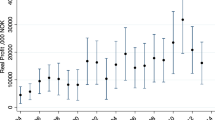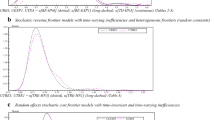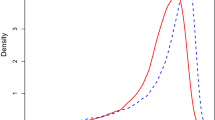Abstract
This paper analyses the pelagic fishery of Northern Chile, estimating harvesting functions that contribute to understand why rather poor incentives to exit may predominate in pelagic fisheries, despite scarcer fish stocks. Our results show that per‐vessel catch's stock sensitivity (the catch‐to‐biomass elasticity value) varies negatively with stock levels. Stock levels preceding a marked fall into biological overfishing would have been associated to biomass elasticities lower than the unitary value. This suggests that during catch bonanza periods, catch‐per‐unit‐of‐effort would fail to detect a rapidly declining stock trend, increasing the risk of fishing collapse. Moreover, external economies in search efforts would have reduced the incentives to exit, particularly for the smaller vessels in our sample. Finally, we find evidence of either constant or increasing marginal returns in the use of per‐vessel fishing effort, which suggests that inefficiency in production has resulted from direct restrictions upon fishing effort. Overall, our findings provide consistent evidence that enhances the necessity of more efficient regulations upon harvesting in pelagic fisheries.
Similar content being viewed by others
References
N. Abuaf and P. Jorion, Purchasing power parity in the long run, Journal of Finance 45 (1990) 157-174.
B.H. Baltagi, Econometric Analysis of Panel Data (Wiley, Chichester, UK, 1995).
A. Bhargava, L. Franzini and W. Narendranathan, Serial correlation and fixed effects model, Review of Economic Studies 49 (1982) 533-549.
T. Bjørndal, Production in a schooling fishery: The case of the North Sea herring fishery, Land Economics 65 (1989) 49-56.
T. Bjørndal, The optimal management of North Sea herring, Journal of Environmental Economics and Management 15 (1988) 9-29.
T. Bjørndal and J. Conrad, The dynamics of an open access fishery, Canadian Journal of Economics 20 (1987) 74-85.
D.S. Butterworth, K.L. Cochrane and J.A. De Oliveira, Management procedures: A better way to manage fisheries? The South African experience, in: Global Trends: Fisheries Management, eds. E.K. Pititch, D.D. Huppert and M.P. Sissenwine, American Fisheries Society (AFS) Symposium 20, Proceedings, AFS, Maryland (1997).
H.F. Campbell and R.B. Nicholl, Can purse seiners target Yellowfin tuna?, Land Economics 70 (1994) 345-353.
J.W. Chung, Utility and Production Functions. Theory and Applications (Blackwell, Oxford, 1994).
C. Clark, Mathematical Bioeconomics: The Optimal Management of Renewable Resources (Wiley, New York, 1976).
C. Clark, Concentration profiles and the production and management of marine fisheries, in: Economic Theory of Natural Resources, eds. W. Eichhorn, R. Henn, K. Neumann and R.W. Shepard (Physica-Verlag, Wurzburg, 1982).
C. Clark and G. Munro, Fisheries and the processing sector: Some implications for management policy, Bell Journal of Economics 11 (1980) 603-616.
C. Crone-Bilger, International and economic policy aspects of the Soviet Ocean-going fishing industry, Ph.D. thesis in Economics, University of London, UK (1990).
J. Csirke, in: Small Shoaling Pelagic Fish Stocks, ed. J.A. Gulland (1988) chapter 11.
J. Csirke and A. Gumy, Análisis bioeconómico de la pesqueria pelágica Peruana dedicada a la producción de harina y aceite de pescado, Boletin IMARPE, Vol. 15(2), Callao, Peru (1996) 68 p.
D.H. Cushing, The Provident Sea (CUP, Cambridge, UK, 1988).
J.H. Davidson, D.H. Hendry, F. Srba and S. Yeo, Econometric modeling of the aggregate time-series relationship between consumers' expenditure and income in the United Kingdom, The Economics Journal 88 (1978) 661-692.
D.A. Dickey and W.A. Fuller, Distribution of the estimators for autoregressive time series with a unit-root, Journal of the American Statistical Association 74 (Part 1) (1979) 427-431.
D.A. Dickey and W.A. Fuller, Likelihood ratio statistics for autoregressive time series with a unitroot, Econometrica 49 (1981) 1057-1072.
P.B. Doeringer and D.G. Terkla, Troubled Waters. Economic Structure, Regulatory Reform and Fisheries Trade (University of Toronto Press, Toronto, 1995).
W. Greene, Econometric Analysis, 2nd edn (Macmillan, New York, 1993).
J.A. Gulland ed., Fish Population Dynamics, 2nd edn (Wiley, Chichester, UK, 1988).
R. Hannesson, Bioeconomic production function in fisheries: Theoretical and empirical analysis, Canadian Journal of Fisheries and Aquatic Sciences 40 (1983) 968-982.
D.F. Heathfield and S. Wibe, An Introduction to Cost and Production Functions (Macmillan, London, 1987).
IFOP, Sistema de Información Pesquera: Pesquerías Pelágicas (Santiago, Chile, 1988).
J.E. Kirkley, D. Squires and I.E. Strand, Assessing technical efficiency in commercial fisheries: The Mid-Atlantic Sea scallop fishery, American J. of Agricultural Economics 77 (1995) 686-697.
A. Koutsoyiannis, Theory of Econometrics, 2nd edn (Macmillan, London, 1986).
D. Lipton and I.E. Strand, The effect of common property on the optimal structure of the fishing industry, J. of Environmental Economics and Management 16 (1989) 45-51.
P. Manning, Managing Namibia's marine fisheries: Optimal resource use and national development objectives, Ph.D. thesis, Development Studies Institute, LSE, University of London, December 1997 (1998).
A.E. McEvoy, The Fisherman's Problem. Ecology and Law in the California Fisheries 1850-1980 (CUP, Cambridge, UK, 1986).
K. McKelvey, The fishery in a fluctuating environment: Coexistence of specialist and generalist fishing vessels in a multipurpose fleet, J. Environmental Economics and Management 10 (1983) 287-309.
G. Munro, Bilateral monopoly in fisheries and optimal management policy, in: Essays in the Economics of Renewable Resources, eds. L. Mirman and D. Spulber (North-Holland, Amsterdam, 1982) chapter 10.
W. Newey and K. West, A simple positive semi-definite, heteroscedasticity and autocorrelation consistent covariance matrix, Econometrica 55 (1987) 703-708.
J. Peña, Economic analysis of marine industrial fisheries, Ph.D. thesis, Economics Department, QMW College, University of London, UK (1996).
J. Peña, Chilean fishing regulation: A historical perspective, Cuadernos de Economia 100 (1996) 367-395.
J. Peña, The political economy of fishing regulation: the case of Chile, Marine Resource Economics 12 (1997) 239-248.
J. Peña, Harvesting preemption, industrial concentration and enclosure of national marine fisheries, Environmental and Resource Economics 14 (1999) 545-571.
M.H. Pesaran and R. Smith, Estimating long-run relationships from dynamic heterogeneous panels, Journal of Econometrics 68 (1995) 79-113.
J.P. Platteau, Penetration of capitalism and persistence of small-scale organizational forms in Third World fisheries, Development and Change 20 (1989) 621-651.
J.P. Platteau and J. Nugent, Share contracts and their rationale: Lessons from marine fishing, Journal of Development Studies 28 (1992) 386-422.
D. Sahrhage and J. Lundbeck, A History of Fishing (Springer, New York, 1992).
K.G. Salvanes and F. Steen, Testing for relative performance between seasons in a fishery, Land Economics 70 (1994) 431-447.
W.E. Schworm, Monopsonistic control of a common property renewable resource, Canadian Journal of Economics 16 (1983) 275-287.
C.D. Scott, Land reform and property rights among small farmers in Chile, 1968-86, in: Neoliberal Agriculture in Rural Chile, ed. D.E. Hojman (Macmillan, London, 1990).
K. Stollery, Monopsony processing in an open access fishery, Marine Resource Economics 3 (1987) 331-351.
H. White, A heteroscedasticity-consistent covariance matrix estimator and a direct test for heteroscedasticity, Econometrica 48 (1980) 817-838.
E. Yañez, M.A. Barbieri and O. Barra, Evolución de los principales recursos pelágicos explotados en la zona Norte de Chile entre 1957 y 1985, in: La Pesca en Chile, ed. P. Arana, Escuela de Ciencias del Mar, UCV, Valparaiso, Chile (1986).
A. Zellner, J. Kmenta and J. Drèze, Specification and estimation of Cobb-Douglas production function models, Econometrica 34 (1966) 784-795.
Author information
Authors and Affiliations
Rights and permissions
About this article
Cite this article
Peña‐Torres, J., Basch, M. Harvesting in a pelagic fishery: The case of Northern Chile. Annals of Operations Research 94, 295–320 (2000). https://doi.org/10.1023/A:1018933603839
Issue Date:
DOI: https://doi.org/10.1023/A:1018933603839




